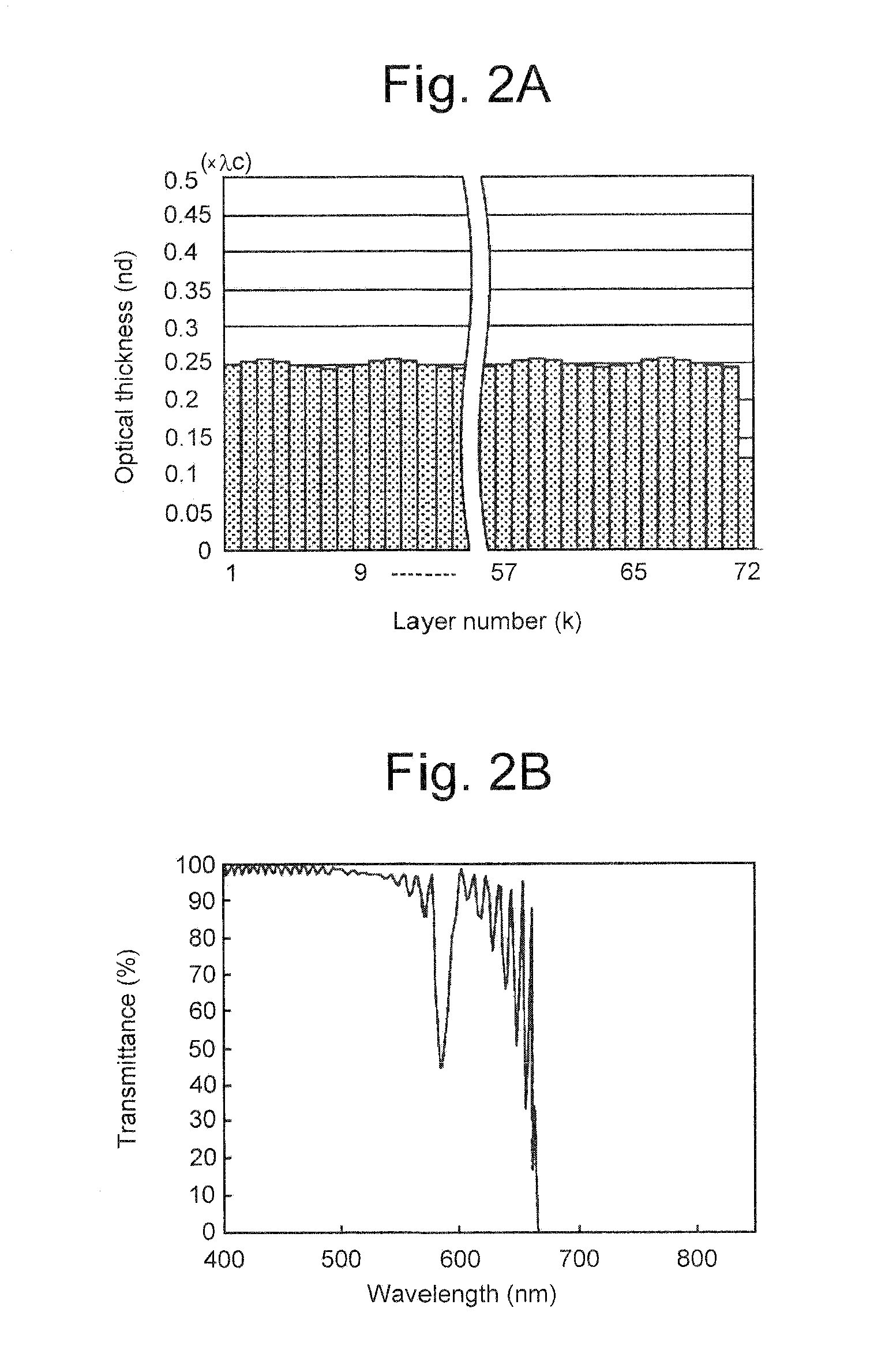Optical filter
- Summary
- Abstract
- Description
- Claims
- Application Information
AI Technical Summary
Benefits of technology
Problems solved by technology
Method used
Image
Examples
embodiment i
[0072]Six optical filters PEI-1 to PEI-6 were prepared as practical examples of the first embodiment, and one optical filter CEI-1 as a comparative example. Table I shows specific numerical data of the practical optical filters PEI-1 to PEI-6 and the comparative optical filter CEI-1. As shown in Table I, the individual optical filter, practical or comparative, was made up of nine layer-stacks identical with one another, each layer-stack consisting of eight alternative layers of high refractive index and low refractive index, and hence, made up of 72 layers in total and had a reflection band centered at a wavelength of 750 nm.
TABLE ICenterTotalwavelengthRatio of opticalRate ofPitch angleNumber ofnumber(.c nm)thickness (β)amplitude(a)(θ°)layer-stacksof layersCEI-17501045972PEI-175010.02545972PEI-275010.0545972PEI-375010.07545972PEI-475010.145972PEI-575010.245972PEI-675010.345972
[0073]As shown in Table I, the practical optical filters PEI-1 to PEI-6 were different only in the rate of a...
embodiment ii
[0076]Two optical filters PEII-1 and PEII-2 were prepared as practical examples of the second embodiment, and one optical filter CEII-1 as a comparative example. Table II shows specific numerical data of the respective optical filters PEII-1 to PEII-2 and CEII-1. As shown in Table II, the practical optical filters PEII-1 and PEII-2 of the second embodiment had the same specific numerical data as the practical optical filter PEI-2 of the previous embodiment, except for pitch angles (.) and the numbers of layer stacks. The comparative optical filter CEII-1 was similar to the practical optical filters PEII-1 and PEII-2 and, however, had a pitch angle of 0° which means that all of the layers have the same optical thickness (n×d=0.25.c). The practical optical filter PEII-1 was made up of six layer-stacks, each layer-stack consisting of 12 alternative layers of high refractive index and low refractive index, and hence, made up of 72 layers in total and the practical optical filter PEII-2 ...
embodiment iii
[0079]Three optical filters PEIII-1 to PEIII-3 were prepared as practical examples of the third embodiment. Table III shows specific numerical data of the respective practical optical filters PEIII-1 to PEIII-3. As shown in Table III, the practical optical filters PEIII-1 to PEIII-3 had the same specific numerical data as the practical optical filter PEI-2 of the first embodiment, except for the number of layer-stacks and the total number of layers, respectively. Specifically, the practical optical filter PEIII-1 to PEIII-3 were made up six, 12 and 15 layer-stacks, respectively, each of which consisted of the same number of, i.e. eight alternative layers of high refractive index and low refractive index, and consisted of 48, 96 and 150 layers in total, respectively.
TABLE IIICenterTotalwavelengthRatio of opticalRate ofPitch angleNumber ofnumber(.c nm)thickness (β)amplitude(a)(θ°)layer stacksof layersPEIII-175010.0545648PEIII-275010.05451296PEIII-375010.054515120
[0080]Investigation wa...
PUM
 Login to View More
Login to View More Abstract
Description
Claims
Application Information
 Login to View More
Login to View More - R&D
- Intellectual Property
- Life Sciences
- Materials
- Tech Scout
- Unparalleled Data Quality
- Higher Quality Content
- 60% Fewer Hallucinations
Browse by: Latest US Patents, China's latest patents, Technical Efficacy Thesaurus, Application Domain, Technology Topic, Popular Technical Reports.
© 2025 PatSnap. All rights reserved.Legal|Privacy policy|Modern Slavery Act Transparency Statement|Sitemap|About US| Contact US: help@patsnap.com



